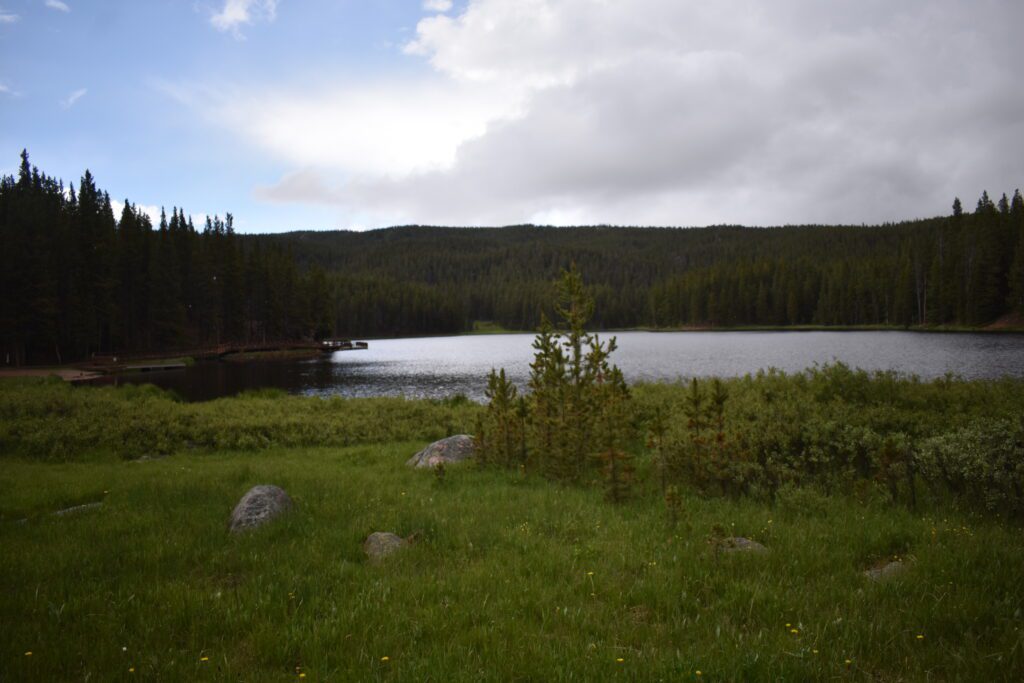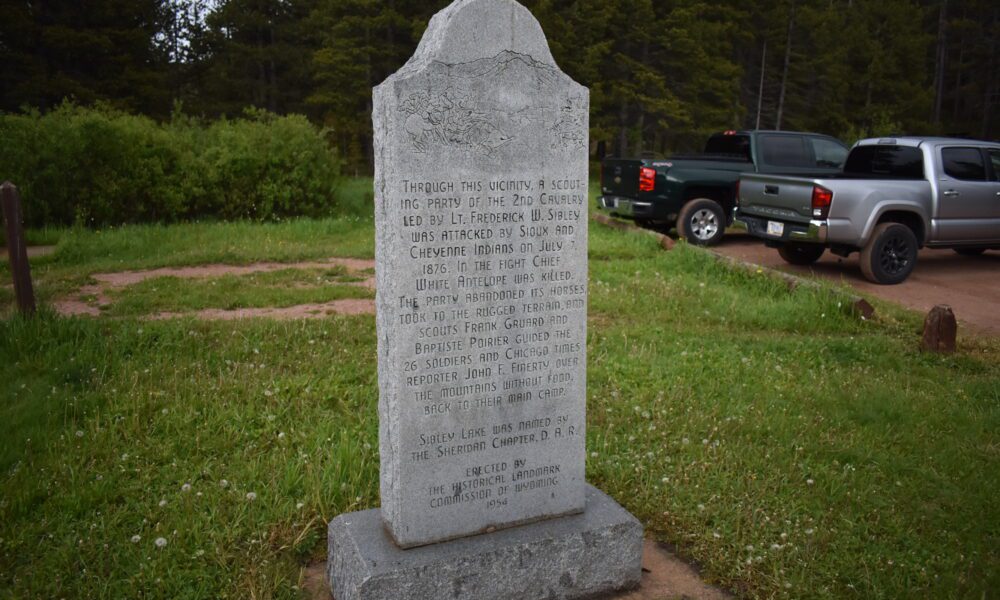Nearly 150 years ago this week, one of the most thrilling escapes in the history of the Wyoming Indian Wars took place in the Bighorn Mountains not far from Dayton, Wyoming. Texan-born Frederick W. Sibley, a lieutenant in the Second Cavalry under General Crook, encountered a band of Sioux and Cheyenne Indians near what is now Sibley Lake.
Sibley was born in 1852 and entered the West Point Military Academy at age 16. He was commissioned a second lieutenant in the 2nd Cavalry in 1874. He served with General Crook’s Big Horn Expedition in 1876. He participated in the Battle of Powder River in Montana Territory and the Battle of Rosebud in June of that year.
On July 7, 1876, Sibley’s men encountered a large force of Sioux and Cheyennes during a scouting expedition. His men managed to escape, and not a single man was wounded during the battle.

Sibley Lake
A detailed account of the battle appeared in the Cheyenne Weekly Leader of July 22, 1876: Sibley’s Scouts. One of the most thrilling adventures in the annals of the border. A party of 30 scouts under the command of Lieutenant Sibley, Second Cavalry, was sent out from Crook’s camp on July 6th to observe the movements and positions of the Sioux Indians, and, if possible, to learn the location of Terry.
On the 9th they returned on foot after a frightening retreat of two nights and one day. They were surrounded by vast numbers of the enemy and miraculously escaped at the cost of all their equipment and ammunition, including 33 pack horses and 2 mules. None of them would have survived but for the sagacity and caution of their guides, Grouard and Baptiste, and the judgment and bravery of Sibley.
They marched all through the night of the 9th toward the headwaters of the Little Bighorn River. On the 7th, after a light meal, they made their way through some foothills toward the mountains. About half-past four o’clock a large body of Sioux was seen from the bluffs marching eastward. They seemed to be spread over the whole plain, and were evidently moving to attack the camp on Goose Creek.
Sibley’s party remained hidden for about an hour, watching their movements with great anxiety, when presently a loud cry was heard which indicated that the trail they were looking for had been found. Instantly hundreds of Indians appeared, and broke into pursuit at full speed, uttering the terrible wolf-like cry peculiar to the Sioux and Cheyennes.
Sibley’s men mounted and galloped towards the mountains. The Sioux cried out at the first sight of them. They gave chase like hounds on a scent, but splitting into two parties, they made two detours to reach higher ground through which the pursuers were sure to pass. The scouts climbed the outer edge and were approaching the shelter when suddenly a volley of fifty shots was fired from the rocks around where the Indians had gathered.
More of the enemy fell upon them with a furious fury, and the whole platoon trembled with despair. They turned and ran towards the trees in the valley, where another volley followed them. Three horses were wounded before they reached their hiding place. They dismounted on a tree-covered hill and saw the enemy massing at the foot of the hill, while reinforcements were constantly coming up on the higher ground all around.
The roar of the volleys was deafening. All the bullets flew high, but the enemy gradually took aim. The bravest Indians who attacked seemed to be raising the Cheyenne battle cry. The volleys continued for an hour, the scouts barely returning fire to conserve ammunition, but suddenly there was a lull that seemed to portend some new disaster. The party held a short council and resolved to tie their horses to trees and escape deeper into the mountains, to attract the attention of the Sioux. All the ammunition was removed from the saddles, and the party crept out of the ground and ran behind a protruding rock.
The Sioux, unaware of them, climbed the slippery cliffs, and grew weary. After a short rest, the firing began to intensify again. The volleys were so fierce that the Sioux thought they were still in the way. The scouts began to climb again, and the sound of rifle fire continued until it died away in the distance.
They crossed the mountains and rested under a cliff until dawn on the 8th of July. They again abandoned all hope when they saw a large body of Sioux moving in the foothills to intercept them. But the body turned towards the Tongue River. They thought it was the rear guard of a larger force advancing to attack the camp or wagon train. They had abandoned all their provisions and were very hungry. About dawn on the 9th they reached the banks of the Tongue River.
The two men were too exhausted to cross the rapids, so they hid in the brush and were left behind, one of them going mad with fatigue and fear. The Sioux were sighted a few miles further south, but fortunately the fugitives were not discovered. Four miles from the camp, a packman lent one of the scouts a mule, and the news was conveyed to the colonel who was in command in Crook’s absence. About two companies of cavalry took the horses and marched out to take them. They were so fatigued that they could only march 100 yards without falling to the ground before joining their replacements.

Sibley Lake Bighorn Mountains
And here is General Crook’s report of Sibley’s scouting, which appeared in the Cheyenne Weekly Leader, July 29, 1876: The following is General Crook’s report to General Sheridan, concerning Lt. Sibley’s famous scouting. “Camped at Goose Creek, Wyoming, July 16th, via Fort Fetterman, July 19th. I sent Lieutenant Sibley with a small detachment of the Second Cavalry on the 6th to scout for my guide, Frank Gruard. On the 7th, as they reached the point where the Little Big Horn descends from the mountains, they encountered a large number of Sioux, and saw enough to convince them that the main village of the enemy was not far from the point. Abandoning their livestock, they marched over the rugged foothills of the Big Horn Mountains, and at last succeeded in making their escape. Sibley and Frank Gruard deserve much praise for the coolness and judgment which saved their detachment when surrounded by overwhelmingly superior forces. (Signed) Brigadier General George Crook.

Close-up of the Sibley Lake Memorial
The story then appeared in the Aug. 7, 1876, edition of the Laramie Weekly Sentinel.
Sibley’s Scouts. The bravest feat in this Sioux war was performed by Lieutenant Frederick W. Sibley of the Second Cavalry, Fort Sanders. Of the men of Sibley’s company, Louisville Courier-Journal correspondent at Crooks’ headquarters said: “It was as if an omnipotent God had guided and protected them, and that they all returned unscathed. There were as many old Indian warriors in this company as could possibly be found in the country, and even our guides had never heard of such a miraculous adventure and happy ending.”
Frank Gruard, about whom I have written many times, freely admits this. Many times he thought of giving up all hope and committing suicide, but only after he had done all he could. Lieutenant Sibley tells us that three times he gave up all hope and prepared to die by his own pistol.
Lieutenant Sibley spent last winter at Fort Sanders, where his quiet demeanor and genial nature have won him many friends among the citizens. He was graduated from West Point in June, 1874, and although he has been in the field for only a little more than two years, he has made a brilliant name for himself in his profession. To have escaped from such overwhelming difficulties without a single casualty sounds more like a tale of romance than the solemn truth of history, but he will undoubtedly be duly rewarded by the authorities in Washington.
For his leadership and bravery, Sibley was brevet promoted to first lieutenant and was later recommended for the Medal of Honor.
Near Sibley Lake in the Bighorn Mountains, not far from Burgess Junction, is a monument erected by the Wyoming Historic Landmarks Commission in 1954. The Sheridan Chapter of the DAR named the lake in honor of this accomplished commander.


